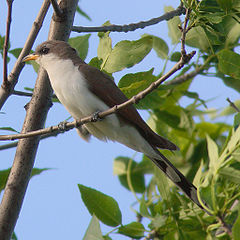Yellow-billed cuckoo
| Yellow-billed cuckoo | |
|---|---|
 |
|
| Scientific classification | |
| Kingdom: | Animalia |
| Phylum: | Chordata |
| Class: | Aves |
| Order: | Cuculiformes |
| Family: | Cuculidae |
| Genus: | Coccyzus |
| Species: | C. americanus |
| Binomial name | |
|
Coccyzus americanus (Linnaeus, 1758) |
|
The yellow-billed cuckoo (Coccyzus americanus) is a cuckoo. Common folk-names for this bird in the southern United States are rain crow and storm crow. These likely refer to the bird's habit of calling on hot days, often presaging thunderstorms.
The genus name is from Ancient Greek kokkuzo, which means to call like a common cuckoo, and americana means "of America".
Adults have a long tail, brown above and black-and-white below, and a black curved bill with yellow especially on the lower mandible. The head and upper parts are brown and the underparts are white. There is a yellow ring around the eye. It shows cinnamon on the wings in flight. Juveniles are similar, but the black on the undertail is replaced by gray.
This bird has a number of calls; the most common is a rapid ka ka ka ka ka kow kow kow.
There is an ongoing debate regarding the taxonomic status of the western race and if it is distinct from those birds in the east. This question is significant to the conservation status of this species in the west, where it has declined to a tiny fraction of its population a century ago. Populations of this species in western North America are in steep decline. The bird disappeared from British Columbia, Washington, and Oregon during the first half of the twentieth century. Eastern populations have declined as well, though not as precipitously. The United States Fish and Wildlife Service has proposed listing the western Distinct Population Segment (DPS) of Yellow-billed Cuckoos as threatened under the Endangered Species Act, and the service also has proposed establishing 546,335 acres in nine western states as critical habitat for the western DPS of the Yellow-billed Cuckoo.
Their breeding habitat is deciduous woods from southern Canada to Mexico. They migrate to Central America and as far south as northern Argentina. This bird is a rare vagrant to western Europe.
...
Wikipedia

